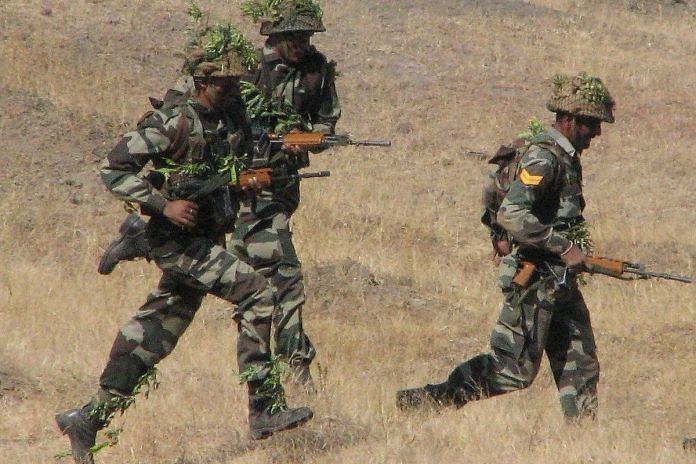The surgical strikes indicated a threshold for Indian response. Kashmir, however, will continue to simmer.
On 29 September 2016, Indian Army special forces struck militant positions “along” the Line of Control, in Pakistan-controlled Kashmir. The operations — described as “surgical strikes” in a joint Indian Ministry of External Affairs and Indian Ministry of Defence briefing — were an act of swift retaliation for a deadly attack just eleven days earlier on Indian security forces in Uri, in Kashmir’s Baramulla district, by heavily armed and well-trained attackers affiliated with Pakistan-based Jaish-e-Mohammed.
The death toll in Uri was the Indian Army’s highest in decades and, in the aftermath of the Pathankot attack in January 2016 and the Gurdaspur attack in the summer of 2015, the Modi government was driven to respond. One year after India’s “surgical strikes,” what can be said about their long-term resonance and efficacy?
First, at the onset of any reflection on these strikes, it’s worth noting that the precise details of what transpired operationally on 29 September along the Line of Control remain murky. Recent reporting, including insight from Lt. General (Retd) D.S. Hooda, has shed considerable detail on the Modi government’s deliberative process, but the tactical outcomes — including death tolls — remain unknown. Nitin A. Gokhale’s new book reports previously unknown details of the operations, including a considerable militant death toll in excess of 70 individuals.
Nevertheless, in the immediate aftermath of the strikes, a paroxysm of excited commentary in India and fierce denial in Pakistan made separating the signal from the noise all the more challenging.
Still, New Delhi’s decision to communicate the fact of the strikes as it did — with a carefully worded statement from its Director-General of Military Operations (DGMO) — appears now to have struck the right balance. Making clear that the strikes were pre-emptive in nature and based on “very credible and specific information”, the DGMO did not say anything that wouldn’t allow for Pakistan to stave off domestic escalatory pressure.
Rawalpindi was able to deny the fact of the strikes — something that would have been infinitely more challenging had Indian government sources leaked video footage or images to the press. Finally, the Indian statement was careful in restricting its scope to the militants themselves, aside from a thinly veiled reference to “those who are trying to support them”.
Second, contrary to one strain of analysis that loomed large in the immediate aftermath of the strikes themselves, the Modi government’s decision to apply Indian hard power across the Line of Control did not indicate an end to or modification of India’s posture of “strategic restraint” vis-a-vis Pakistan. Moreover, India’s strategic options against Pakistan more broadly were not recalibrated after the strikes. The joint MEA-MoD briefing last year sought to make this clear by noting the precise and proportional application of military force across the Line of Control; nothing about the strikes risked conventional military escalation.
One year on, rather, the lesson of the events of 29 September 2016, should be that the Indian Army continues to have retaliatory space across the Line of Control — options that aren’t available to it across the international border with Pakistan, where the threat of military escalation is real and assured. Extending this further, the surgical strikes should not imply that Indian Army special operators can or should operate regularly across the Line of Control to engage the Pakistani military either pre-emptively or early in a conventional conflict.
Third, as recent revelations have made clear, the decision to retaliate after Uri was a calculated risk that took the success of the June 2015 special forces operation across the border with Myanmar into account. During that raid, which was carried out in coordination with the Burmese government—an important difference with the September 2016 strikes—the Modi government not only discovered the deterrent value of retaliatory action, but the subsequent domestic political plaudits made proportional retaliation more likely against Pakistan-based militants as well.
Finally, examining the situation along the Line of Control over the past year, it’s less clear now that the strikes succeeded in creating a deterrent effect. Uri, of course, was far from the last attack by armed infiltrators across the Line of Control; Indian security forces in Kashmir continue to face threats from militants backed by the Pakistani military. Of course, no respectable analysts ever claimed that one strike would fundamentally alter the strategic calculus of India’s adversaries in Kashmir, and that was for a good reason.
The costs of brinksmanship and perpetual sub-conventional war in Kashmir remain tolerable for Pakistan’s military-intelligence complex. The September 2016 strikes, if anything, indicated a threshold for Indian response. In the meantime, Kashmir will continue to simmer.
The author is a senior editor at The Diplomat
Also read: What did India’s surgical strike against terrorists in Pakistan achieve?






